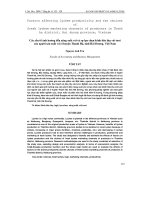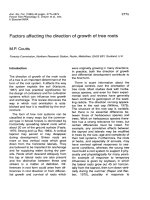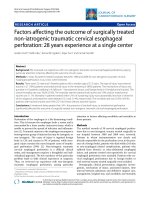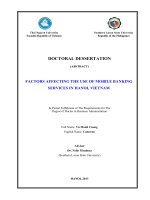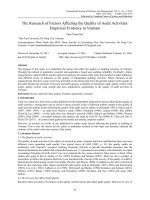779 Factors Affecting The Credibility Of Online Reviews On Tiki Bachelor Thesis Of Business Adminstration 2023.Docx
Bạn đang xem bản rút gọn của tài liệu. Xem và tải ngay bản đầy đủ của tài liệu tại đây (748.46 KB, 114 trang )
MINISTRYOF EDUCATION ANDTRAINING
STATEBANKOFVIETNAMBANKINGUNIVERSITYOFHOCHIMINH
CITY
CANTHUKIET
FACTORS AFFECTING THE CREDIBILITY
OFONLINEREVIEWS ON TIKI
BACHELORTHESIS
MAJOR:BUSINESSADMINISTRATIONC
ODE:7340101
HOCHI MINHCITY,2020
MINISTRYOF EDUCATION ANDTRAINING
STATEBANKOFVIETNAMBANKINGUNIVERSITYOFHOCHIMINH
CITY
CANTHUKIET
FACTORS AFFECTING THE CREDIBILITY
OFONLINEREVIEWS ON TIKI
BACHELOR
THESISBUSINESS
ADMINISTRATIONCODE:73401
01
SUPERVISORTR
ANVANDAT,PhD
TĨMTẮT
Sự phát triển của internet và phương tiện truyền thơng xã hội trực tuyến đã
thayđổi cách mọi người giao tiếp với nhau. Trong bối cảnh này, các đánh giá trực
tuyến,một hình thức truyền miệng điện tử đặc biệt (eWOM), đã nổi lên như một kênh
truyềnthông mới và ngày càng trở nên phổ biến. Ngày nay, các đánh giá trực tuyến là
mộttrong những nguồn thơng tin có ảnh hưởng nhất đối với người tiêu dùng khi hình
thànhquyếtđịnhmuahàng.Tuynhiên,hiệnnaycórấtnhiềucácđánhgiásailệchdonhiềungun nhân khác nhau gây
ảnh
hưởng
nghiêm
trọng
đến
thương
hiệu.
Từ
đó,
vấn
đềđặtralàđánhgiátrựctuyếnđángtincậylànhư thếnào.
Đề tài“Các yếu tố ảnh hưởng đến độ uy tín của các đánh giá trực tuyến
trênTIKI”được thựctại thànhphố Hồ ChíMinhtrong thời giantừc uối tháng10/
2019đếnđầutháng1/2020.Mẫuđượclấytheophươngphápthuậntiệnvớicỡmẫuđượcchọnlà499.
Mục tiêu nghiên cứu là tìm ra yếu tố ảnh hưởng tới độ tin cậy của các đánh
giátrực tuyến trên TIKI. Trên cơ sở đó, đề xuất hàm ý quản trị để góp phần nâng cao
hiệuquảkinhdoanhtrựctuyếncủacácdoanhnghiệp.
Các phương pháp được sử dụng trong đề tài gồm: phương pháp thống kê mơ
tả,Cronbach’s Alpha, phân tích nhân tố EFA, phân tích mơ hình hồi quy và kiểm định
sựkhácbiệtgiữacácnhómđặcđiểmnhânkhẩuhọc(ANOVA).
Kết quả cho thấy có 6 yếu tố ảnh hưởng độ tin cậy của các đánh giá trực
tuyếntrên TIKI là: “Tính chính xác”, “Tính đầy đủ”, “Số lượng đánh giá”, “Tính nhất
quán”,“Đánhgiávềsảnphẩmhoặcdịchvụ”và“Uytíncủawebsite”.
1
ABSTRACT
Today, marketers consider social media to promote their products. Social
mediahas become a very important tool that enables marketers to communicate with
theircustomers. After the significant development of the internet and online social
media,people have started to share their opinions about products through online
reviews. Evenmore, consumers consider online reviews to be a more reliable source of informationthan traditional
sources (Fang et al., 2016). Previous studies have shown that onlinereviews can play
an
important
role
in
consumer
2014;MudambiandSchuff,
shopping
2010;Zhang,Zhao,et.
behavior
al.,
(Yin
et
al.,
2014).Specifically,
informationgenerated by consumers, such as online reviews, is more persuasive than
informationgeneratedbymarketers,becauseconsumershavenobenefitsandarethereforein
dependent and trustworthy. more reliable (Park et al., 2007; Plotkina and
Munzel,2016;ReimerandBenkenstein,2016).
Currently, in various e-commerce websites, online reviews are given along
withproduct descriptions, enabling consumers to make the right purchase decision. As
aresult, consumers search online reviews for brand gadgets, which ultimately
affectsconsumer buying intent. However, fake online reviews have made consumer
reviewsmore difficult and negatively impact the brand image. For this reason, the
reliability
ofonliner e v i e w s i s e s s e n t i a l w h e n m a k i n g p u r c h a s e d e c i s i o n s b a s e d o n t h
o s e r e v i e w s and
contributes
to
protecting
the
brand
image
in
public.
Therefore,
the
implementationoft h e r e s e a r c h : " F A C T O R S A F F E C T I N G T H E C R E D I B I
LITYOFONLINE
REVIEWSONTIKI"aimstoidentifyandtestthedeterminantsaffectingt h e credibility
of
online reviews. At the same time, create a premise to study the impact
ofonlinereviewsonconsumerbuyingintent.
The research model used based on the research of Thomas, MJ, Wirtz, BW,
&Weyerer,J C ( 2 0 1 9 ) i n c l u d e s A c c u r a c y , C o m p l e t e ne s s , T i m e l i n e s s , R e v i e
w Q ua n t i t y ,
ReviewConsistency,ReviewerExpertise,Product/ServiceRating,andWebsiteReputation.
Researchdataisrandomlycollectedthroughtheformofanonlinesurveyconducted by
a Google form tool and a field survey by going to universities and cafes.Thereby, 460
samples were collected, of which 11 were not valid due to ignoring thequestion, so
there were only 499 valid samples. SPSS 20 is used in the thesis to analyzedata and test
assumptions.Thesurveyparticipantsareonlineshopperswhoregularlyusesocialmedia.
After the data collection process is completed, all data is put into SPSS 20.
Theprocess of checking and analyzing the data sequentially follows: reliability test,
EFAfactor analysis, Correlation analysis, Multiple linear regression analysis. Initially,
thescale will be assessed by Cronbach's Alpha and EFA. Then, the correlation
coefficienttest is used to check the linear relationship between the independent and
dependentvariables. If the independent variables are strongly correlated, the
multicollinearityproblem must be considered when regression analysis. Finally,
regression analysis isused to determine the impact of independent variables on
dependent variables (Onlinereviewscredibility).
The results show that all Cronbach's alpha is above 0.7 and the correlation of
thevariablesinthescale>0.4.Theseitemswerethenanalyzedbydiscovery factoranalysis (EFA)
with
the
Principal
components
method
for
extraction
and
Varimaxmethodforrotation.Theresultspresentedthatnightfactorswereextractedfrommeasurem
entscaleswiththeextractionsumofsquaredloadingsbeingabout66,350%(greater than 50%). The KMO index was
significant
at
0.781
and
Barlett’s
test
result
is528withSig=
0.000<0.05.Ingeneral,datacanbeusedforanalysis.
Next,correlationanalysisshowedthatsomeindependentvariablesw e r e correlatedw i t h
e a c h o t h e r . T h e r e f o r e , r e g r e s s i o n a n a l y s i s s h o u l d p a y attention t o t h e
problemofmulticollinearity.Theindependentvariablesarecorrelatedwiththedependentvariablesandtheref
orewillbeincludedinthemodeltoexplainthedependent variables. However, there are 2
variables
ACC
(accuracy)
and
RE
(expertevaluation)withsig>0.05,twovariablesarenotcorrelatedwiththedependentvariable
s.
Finally,regressionanalysisshowedthatAccuracy,Completeness,ReviewQuantity,
Review Consistency, Product / Service Rating, and Website Reputation areaccepted
and
all
of
them
have
a
positive
effect
on
Review
Credibility.
In
particular,completeness (0.378) and website reputation (0.243) are the two factors that
have thebiggest impact on the credibility of online reviews. That shows shoppers are
veryinterested in completeness, the full information as well as necessary evidence to
helpshoppers can assess the truthfulness andaccuracy ofthe informationmore
easily.A t the same time, the website reputation also helps increase the credibility of
the reviews,buyers tend to believe in online reviews if the website has a good
reputation.
Basically,theresearchcompleteditsoriginalpurposeofidentifyingfactorsthataffectthecredi
bilityofonlinereviews.
Through the research, there are some interesting findings that seem to have
somesort of spillover effect between website reputation and reputation rating. In
previousresearch (Thomas, MJ, Wirtz, BW, & Weyerer, JC, 2019), the reputation of a
websitehas the strongest impact on the reliability of online reviews. In addition, there
is theopposite of the review quantity factor when in the study of Thomas, MJ, Wirtz,
BW, &Weyerer,JC(2019)thereviewquantityshowedasignificantnegativeimpactontheonline review credibility, this
is
contrary
to
the
result
in
this
paper
as
previousstudies(Fanetal.,2013).Somoreexaminationofthisresultisneeded.
well
as
While the study provides important information on the impact and effect of
thecredibilityo f o n l i n e r e v i e w s , i t s t i l l h a s l i m i t a t i o n s t h a t n e e d t o b e t a k
enseriously.
Accordingly, future research may meet these limitations to make research results
morevaluable. Firstly, empirical research is conducted at a number of universities in
Ho
ChiMinhCityandmainlyusersonthee-
commerceplatformTIKI,soitsresultsmaynotbecompletereflectintheVietnamesecontext.Thereliability
ofthisfindingbecomeshigher if the survey is repeated in other cities with larger sample sizes.
Second, asmentioned, the effective relationship between the review quantity and the
credibility ofonline reviews requires further testing. From a practical perspective, this
is
a
veryimportantandurgentissue,asitisofstrategicsignificancetocompaniest h a t participate
intheonlineevaluationoftheirproductsorservices.
ACKNOWLEDGE
Firstly,I w o u l d l i k e t o e x p r e s s m y d e e p g r a t i t u d e a n d s i n c e r e g r a t i t u
d e t o D r . Tran Van Dat for supporting and helping me in the process of completing the
thesis.Fromthebottomofmyheart,thankyousomuch.
Secondly, I would like to thank my relatives, friends, people from directly
orindirectlyhelpingmeduringtheresearchprocess.
Finally,atthistime,Ideclarethatthisgraduatethesisistheauthor'so w n research,theres
ultsoftheresearcharehonest,inwhichnoneofthepreviouslypublishedcontentorthecontent
madebyothersexceptforfullcitationsinthethesis.
CONTENTS
TÓMTẮT........................................................................................................................ I
ABSTRACT..................................................................................................................II
ACKNOWLEDGE.......................................................................................................VI
CONTENTS................................................................................................................ VII
LISTOFFIGURES.........................................................................................................X
LISTOFTABLES..........................................................................................................X
LISTOFABBREAVIATIONS.....................................................................................XI
CHAPTER1.INTRODUCTION.....................................................................................1
1.1. Problemstatement.................................................................................................1
1.2. Researchobjectives...............................................................................................2
1.3. Researchquestion.................................................................................................2
1.4. Researchsubjectandscope.....................................................................................2
1.5. Significantofthestudy...........................................................................................3
1.5.1. Scientificsignificance....................................................................................3
1.5.2. Practicalsignificance.....................................................................................3
1.6. Researchmethod..................................................................................................3
1.7. Structureofthestudy..............................................................................................4
CHAPTER2.LITERATUREREVIEW...........................................................................5
2.1. Theoreticalbackground.........................................................................................5
2.1.1. DeterminantsBasedonArgumentQuality.......................................................5
2.1.2. DeterminantsBasedonPeripheralCues...........................................................6
2.1.3. Credibleonlinereviews..................................................................................8
2.1.4. TIKI..............................................................................................................9
2.2. Previousresearch................................................................................................10
2.3. Hypothesis.........................................................................................................18
2.3.1. Accuracy.....................................................................................................18
2.3.2. Completeness..............................................................................................18
2.3.3. Timeliness...................................................................................................19
2.3.4. Reviewquantity...........................................................................................19
2.3.5. Reviewconsistency......................................................................................19
2.3.6. Reviewerexpertise.......................................................................................20
2.3.7. Productorservicerating................................................................................20
2.3.8. Websitereputation.......................................................................................21
CHAPTER3.RESEARCHMETHODOLOGY..............................................................23
3.1. ConceptualModel...............................................................................................23
3.2. Researchvariables..............................................................................................25
3.3. Researchdesign..................................................................................................29
3.4. Sampleanddatacollectionmethod.......................................................................30
3.4.1. Samplesize..................................................................................................30
3.4.2. Selectsurveysubjects...................................................................................31
3.4.3. Questionnairedesign....................................................................................31
3.4.4. Datacollectionmethod.................................................................................33
3.5. Dataanalysismethod...........................................................................................33
3.5.1. Cronbach’sAlpha........................................................................................33
3.5.2. Exploratoryfactoranalysis(EFA)..................................................................34
3.5.3. CorrelationAnalysis....................................................................................35
3.5.4. Regressionanalysis......................................................................................35
3.5.5. One-wayAnova...........................................................................................36
CHAPTER4.DATAANALYSISANDDISCUSSION...................................................37
4.1. Introduction.......................................................................................................37
4.2. Descriptiveanalysis............................................................................................37
4.2.1. Gender........................................................................................................37
4.2.2. Age.............................................................................................................38
4.2.3. Occupation..................................................................................................38
4.2.4. Income........................................................................................................39
4.2.5. Frequency...................................................................................................40
4.3. Reliabilityofscale...............................................................................................40
4.4. EFAfactoranalysis..............................................................................................42
4.5. CorrelationAnalysis...........................................................................................46
4.6. MultipleLinearRegressionAnalysis....................................................................48
4.7. One-wayAnova..................................................................................................53
4.7.1. Age.............................................................................................................53
4.7.2. Occupation..................................................................................................54
4.7.3. Income........................................................................................................55
4.7.4. Frequency...................................................................................................56
4.8. Discussions........................................................................................................57
CHAPTER5.CONCLUSIONANDMANAGERIALIMPLICATIONS.........................59
5.1. Conclusion.........................................................................................................59
5.2. Managerialimplications......................................................................................59
5.3. Limitations.........................................................................................................61
5.4. Futurestudy........................................................................................................62
REFERENCE...............................................................................................................64
APPENDIXA.DISCUSSIONPLAN.............................................................................67
APPENDIXB.QUESTIONNAIRE..............................................................................70
APPENDIXC.DATAANALYSISRESULT.................................................................73
LISTOF FIGURES
Figure2.1.Thomas,M.J.,Wirtz, B. W.,& Weyerer,J.C. (2019).......................................12
Figure2.2. Thomas,Wirtz,&Weyerer(2019)..................................................................14
Figure2.3.Cheung,C.M.Y.,Sia,C.L.,&Kuan,K.K.(2012)...............................................16
Figure2.4.Cheung,C.M.,Lee,M.K.,&Rabjohn,N.(2008)...............................................17
Figure3.1.ResearchModel.............................................................................................25
Figure3.2.Researchprocedure........................................................................................30
Figure4.1. Officialresearch model.................................................................................53
LISTOF TABLES
Table 3.1. Overview of Exogenous Constructs and Relevant Sources for
ModelDevelopment......................................................................................................21
Table3.2.Indicatorsofscales...........................................................................................25
Table3.3.Contenttodiscussonebyone.............................................................................31
Table4.1.Samplecharacteristicsof gender......................................................................37
Table4.2.Samplecharacteristicsof age...........................................................................38
Table4.3.Samplecharacteristicsofoccupation................................................................38
Table4.4. Samplecharacteristicsof income.....................................................................39
Table4.5.Samplecharacteristicsoffrequency..................................................................40
Table4.6.Cronbach’sAlphacoefficient..........................................................................41
Table4.7.KMOandBartlett'sTest...................................................................................43
Table4.8.TotalVarianceExplained.................................................................................43
Table4.9. RotatedComponent Matrix............................................................................45
Table4.10.Correlations.................................................................................................47
Table4.11.ModelSummary...........................................................................................49
Table4.12.ANOVA.......................................................................................................50
Table4.13.Coefficients.................................................................................................50
Table4.14.One-wayANOVAofAge..............................................................................53
Table4.15.One-wayANOVAofOccupation..................................................................54
Table4.16.One-wayANOVAofIncome.........................................................................55
Table4.17.One-wayANOVAofFrequency....................................................................56
LISTOFABBREAVIATIONS
Acronym
Definition
HCMC
HoChiMinhCity
eWOM
electronic WordOf Mouth
EFA
ExploratoryFactorAnalysis
KMO
Kaiser-Meyer-Olkin
SPSS
StatisticalPackagefortheSocial Sciences
CHAPTER1.INTRODUCTION
1.1. Problemstatement
Int h e i n t e r n e t e r a , t h e d e v e l o p m e n t o f i n f o r m a t i o n a n d c o
m m u n i c a t i o n technology has opened up new opportunities for service providers and consumers toshare
information with each other. In this context, online reviews, a special kind ofelectronic
word
of
mouth
(eWOM),
have
emerged
as
a
new
and
increasingly
popularcommunicationc h a n n e l ( K u a n e t a l . , 2 0 1 5 ; P a r k a n d N i c o l a u , 2
0 1 5 ; W a n g e t a l . , 2018).Today,onlinereviewsareoneofthemostinfluentialsourcesofinformationforconsumers
when making purchase decisions (Chevalier and Mayzlin, 2006; Lee andShin,2014).
Previous research has shown that online user reviews have a significant impact
oncustomerp u r c h a s i n g b e h a v i o r ( C h e v a l i e r a n d M a y z l i n , 2 0 0 6 ; C l e m o n s e t a
l . , 2 0 0 6 ) , andthusaffectproductsales(ChenandXie,2008).Previousstudiesindicatethattheinformation generated by
consumers, such as online reviews, is more persuasive thanthe information created by
the marketer because consumers do not have a benefit andtherefore more independent
and reliable (Park et al., 2007; Plotkina and Munzel, 2016;Reimer and Benkenstein,
2016). Besides, previous studies have shown that reliabilityplays an important role in
consumer decision making and reduces uncertainty (Awadand Ragowsky, 2008; Fan
et al., 2013; Nan et al., 2017). According to Baek et al.(2015, p. 293), credibility is
also the most significant factor in electronic word-of-mouth (eWOM) adoption. For
this reason, the credibility of online reviews seemscrucial when making purchase
decisions
based
on
those
reviews.
Due
to
the
importanceofcredibilityinthecontextofonlinereviewsandassociatedpurchasede
cisions.Thatiswhyonlinereviewscredibilityisamajorconcernforbothconsumersandmarke
ters.
Today,
as
online
reviews
becomemore
accessible
to
internet
users,m a n a g e r s needto no to nl y promotep os i ti ve on li ne in fo rm a t io na bo ut t
he i rb ra nd s / pr od uc ts b ut
1
also need to do reduce the unwanted impact of negative online information on
theirbrands/products.Therefore,
the
reputation
and
useofonline
reviewand
reviews i t e s can be threatened in the long term, if consumer concerns and uncertainties continue tospread and
consolidate. Munzel (2016, p. 96) states that “The increasing practice offake reviews
posted online not only jeopardize [sic] the credibility of review sites asimportant
information sources for individuals but also endangers a valuable source ofinformation
for service providers.” So as to counteract this development initiated bythose rogue
companies, it is vital for reliable companies to understand how shoppersperceive and
assess
the
credibility
of
online
reviews,
and
particularly,
to
grasp
whatfactorsdeterminereviewcredibilityfromtheconsumers’pointofview.
However,uptonow,thereisverylittleresearchinVietnamonthistopic.Therefore, this research
aimstofindoutfactorsaffectingthecredibilityofonlinereviewsonthee-commercewebsiteTIKI.
1.2. Researchobjectives
Themainpurposeofthisstudyistoidentifythefactorsthataffectthereliability
ofonlinereviewsonTIKIfromaconsumerperspective.
Thestudyhastheidentifysub-objectives:
- EvaluatingtheimpactofeachfactoronthecredibilityofonlinereviewsonTIKI.
- Providing managerialimplicationsforbusinesses.
1.3. Researchquestion
- WhatfactorsaffectonlinereviewcredibilityonTIKI?
- Thelevelofinfluenceofeachfactor?
- Which managerialimplicationsforbusinesses?
1.4. Researchsubjectandscope
- Researchsubject:Factorsaffectingthereliabilityofonlinereview.
- Researchrespondents:
The respondents of this study focus on people who made a purchase on
TIKI.Especially young people, who often shop on e-commerce sites, have high
internetaccess. Based on research by Nielsen.com (2015), aged 15-34 (58%) chose to
shop one-commercesites.
- Researchscope:
The study was conducted in Ho Chi Minh City, where e-commerce is the
mostdeveloped in Vietnam. Ho Chi Minh City is a suitable place to carry out this
researchwith high internet users and literacy levels. The study was conducted from
October toJanuary2020.
1.5. Significantofthe study
1.5.1. Scientificsignificance
The paper provides anoverview ofeWOM,e s p e c i a l l y
credibility
r e v i e w o n l i n e on the platform of e-commerce sites. At the same time, the paper
becomes a referencetohelpotherresearchersdeveloptheirresearch.
1.5.2. Practicalsignificance
This study helps marketers, especially e-commerce sites, understand the impact
ofonlinereviewsandbuildmarketingandbrandingstrategies.
1.6. Researchmethod
Theresearchwasconductedusingamixedresearchmethodology,includingqualitativerese
archandquantitativeresearch:
- Qualitativeresearch:conductedtoidentifyresearchconcepts,buildquestionnaires,
measure
and
collect
necessary
researchobjecttoservethequantitativeresearch.
information
related
to
the
- Quantitative research: This study is to test the research model and the
hypothesesin the model. The sample size is n = 449. Data will be collected and
encryptedwith the support of SPSS 20 software. Then, will be tested reliability of
the
scale(Cronbach'sAlpha),Exploratoryfactoranalysis(EFA)andMultiplelinearregres
sion.
1.7. Structureofthestudy
Chapter 1:
INTRODUCTIONChapter2:LITER
ATUREREVIEWChapter3:RESEARC
HMETHOD
Chapter4:DATAANALYSISANDDISCUSSIONCha
pter5:CONCLUSIONANDIMPLICATIONS

